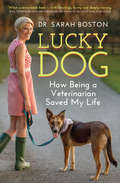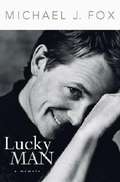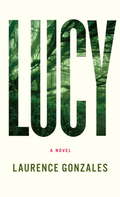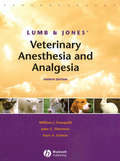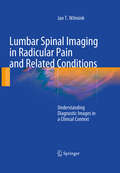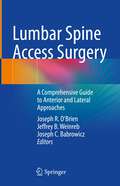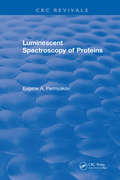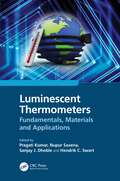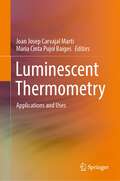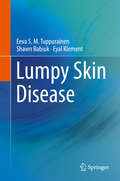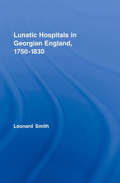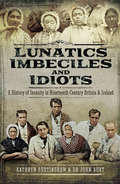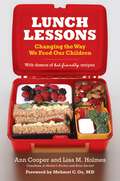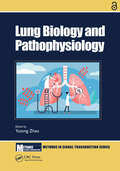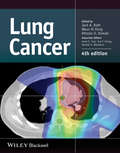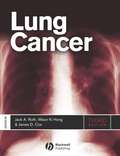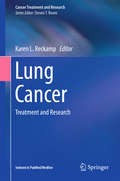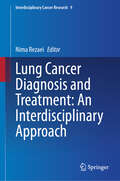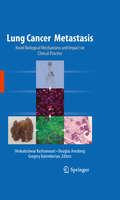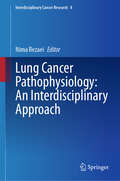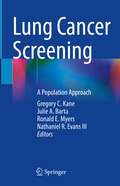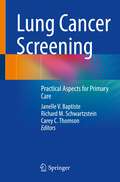- Table View
- List View
Lucky Dog: How Being a Veterinarian Saved My Life
by Sarah BostonLucky Dog is a hilarious and heartwarming memoir by a renowned veterinary oncologist who tells us what we can learn about health care and ourselves from our most beloved pets.What happens when a veterinary surgical oncologist (laymen’s term: cancer surgery doctor) thinks she has cancer herself? Enter Sarah Boston: a vet who suspects a suspicious growth in her neck is thyroid cancer. From the moment she uses her husband’s portable ultrasound machine to investigate her lump — he’s a vet, too — it’s clear this will not be your typical cancer memoir.She takes us on a hysterical and thought-provoking journey through the human health care system from the perspective of an animal doctor. Weaving funny and poignant stories of dogs she’s treated along the way, this is an insightful memoir about what the human medical world can learn from the way we treat our canine counterparts. Lucky Dog teaches us to trust our instincts, be our own advocates, and laugh while we’re doing it.
Lucky Man
by Michael J. FoxIn September 1998, Michael J. Fox stunned the world by announcing he had been diagnosed with Parkinsons disease degenerative neurological condition. In fact, he had been secretly fighting it for seven years. The worldwide response was staggering. Fortunately, he had accepted the diagnosis and by the time the public started grieving for him, he had stopped grieving for himself. Now, with the same passion, humor, and energy that Fox has invested in his dozens of performances over the last 18 years, he tells the story of his life, his career, and his campaign to find a cure for Parkinsons. Combining his trademark ironic sensibility and keen sense of the absurd, he recounts his life from his childhood in a small town in western Canada to his meteoric rise in film and television which made him a worldwide celebrity. Most importantly however, he writes of the last 10 years, during which with the unswerving support of his wife, family, and friends he has dealt with his illness. He talks about what Parkinsons has given him: the chance to appreciate a wonderful life and career, and the opportunity to help search for a cure and spread public awareness of the disease. He is a very lucky man, indeed.
Lucy
by Laurence GonzalesLaurence Gonzales's electrifying adventure opens in the jungles of the Congo. Jenny Lowe, a primatologist studying chimpanzees--the bonobos--is running for her life.A civil war has exploded and Jenny is trapped in its crosshairs . . . She runs to the camp of a fellow primatologist.The rebels have already been there.Everyone is dead except a young girl, the daughter of Jenny's brutally murdered fellow scientist--and competitor.Jenny and the child flee, Jenny grabbing the notebooks of the primatologist who's been killed. She brings the girl to Chicago to await the discovery of her relatives. The girl is fifteen and lovely--her name is Lucy.Realizing that the child has no living relatives, Jenny begins to care for her as her own. When she reads the notebooks written by Lucy's father, she discovers that the adorable, lovely, magical Lucy is the result of an experiment. She is part human, part ape--a hybrid human being . . . Laurence Gonzales's novel grabs you from its opening pages and you stay with it, mesmerized by the shy but fierce, wonderfully winning Lucy.From the Hardcover edition.
Luft und Gesundheit: Von der globalen Zirkulation bis zu Atemwegserkrankungen
by Christian RügerIst frische Luft ein Mythos? In diesem Werk durchstreift der Autor die Lebensräume des Menschen und bietet Einblicke in die jeweils anzutreffenden Luftqualitäten. Aerosole steigen nicht von allein in die Luft auf. Die Partikel lösen sich aus dem festen oder flüssigen Verband. In der Luft kommen alle flugfähigen Masseteilchen miteinander in Kontakt – als ein anschauliches Beispiel dient dem Leser die Entstehung von Wassertropfen. Jede Luftschicht der Atmosphäre wirkt unterschiedlich auf die Atemluft ein und der Wind spielt dabei seine ganz eigene Rolle. Einerseits ist er Verteiler von Schadstoffen, und andererseits Garant frischer Luft am Erdboden. Die Verschmutzung der Luft ruft den Gesetzgeber auf den Plan. Wir erleben derzeit eine rasante Entwicklung von der Aufhebung der Zünfte bis zur Klimadiskussion.Große Relevanz für die Gesundheit besitzt die Schnittstelle zwischen Luft und Mensch: die Atemwege. Deren Schleimhäute stehen im Zentrum unserer Immunabwehr, und müssen einen „Etagenwechsel“ von Infektionen der oberen Atemwege in untere Lungenabschnitte verhindern. Diese und viele weitere spannende Zusammenhänge und Themen im breiten Spektrum zwischen Meteorologie und Atemwegserkrankungen werden anschaulich, gut zugänglich und anhand praktischer Beispiele abgehandelt, um sich eine sichere Plattform zur Beurteilung der Flut von Umweltnachrichten zu schaffen.
Lumb and Jones' Veterinary Anesthesia and Analgesia (Fourth Edition)
by Kurt A. Grimm John C. Thurmon William J. Tranquillish. Later chapters provide detailed coverage of important considerations for specific diseases and types of patients and procedures, including new chapters on the anesthetic management of dental, cancer, orthopedic and equine colic patients. Preliminary sections cover the general principles of anesthesia, physiology and pharmacology, equipment and monitoring, and anesthetic and analgesic techniques. New edition of the definitive reference in veterinary anesthesia. Expanded focus on pain management. Written by international team of experts including more than 65 contributing authors. Covers anesthesia management of domestic and wild species and full array of clinical conditions and diseases.
Lumbar Spinal Imaging in Radicular Pain and Related Conditions
by J. T. WilminkA general consensus exists,that lumbosacral nerve root compression is the primary cause of sciatica and neurogenic claudication, although humoral and vascular factors certainly play a role as well. This book focuses on imaging the various ways in which nerve root compression can come about, and determining which anatomic features are reliably associated with the production of radicular pain. After a discussion of the nature of radicular pain and related symptoms, spinal imaging techniques and options are reviewed, with emphasis on the role of MR myelography in assessing the intradural nerve roots. A chapter on normal topographic, sectional, and functional radiologic anatomy is followed by presentations on pathologic anatomy, addressing mechanisms of nerve root compression, and on pre- and postoperative imaging. Features relevant to prediction of the natural history are discussed, and a section is devoted to the performance and reporting of a spinal imaging study.
Lumbar Spine Access Surgery: A Comprehensive Guide to Anterior and Lateral Approaches
by Joseph R. O’Brien Jeffrey B. Weinreb Joseph C. BabrowiczQuality surgeons must have all the tips, tricks, and tools to provide their patients with the best care possible. Anterior and lateral approaches have revolutionized spine surgery, but even so, many surgeons have not learned the procedures and treatment involved, and the ones who have demonstrate a very difficult learning curve. This can be partially attributed to a lack of instructional literature, and this book aims to fill this gap so that incoming as well as veteran surgeons can add the anterior and lateral approaches to their arsenal. This text guides the surgeon through the full arc of treatment: from deciding which approach to use to treating the patient post-operatively. Specifically, the reader will gain comprehensive knowledge on how to perform each access procedure, how to care for and treat the patient at every stage, and the best ways to handle an array of complications they may face. Seven sections present everything the surgeon needs to know: history and rationale; preoperative and intraoperative care, surgical techniques, intraoperative complications, postoperative care, and a final section covering additional considerations for revision surgery, biological treatments, and approaches for both outpatient and obese patients.Written by experts in the field, Lumbar Spine Access Surgery will be a valuable reference for spine, orthopedic and vascular surgeons looking to expand their skill set.
Luminescent Spectroscopy of Proteins
by Eugene A. PermyakovLuminescent Spectroscopy of Proteins is devoted to the method of intrinsic protein luminescence, one of the most popular experimental methods in modern biophysics and biochemistry. The book discusses general physical principles of the luminescence method; spectral properties of the main protein chromophores; and protein luminescence and its use for studies on structural, physico-chemical, and functional properties of proteins. Principles of luminescent spectroscopy are illustrated by real-life applications and problems. Luminescent Spectroscopy of Proteins will be an excellent reference for biophysicists, biochemists, analytical chemists, and other scientists interested in this topic.
Luminescent Thermometers: Fundamentals, Materials and Applications
by Hendrik C. Swart Sanjay J. Dhoble Pragati Kumar Nupur SaxenaLuminescent Thermometers deals with all aspects of the subject from principles of methods to their applications in different areas. This book familiarizes the readers with the fundamentals of luminescence thermometry, materials used for the development of different luminescence thermometers, viz. metal-organic frameworks (MOFs) including lanthanide-doped MOFs referred as LOFs, quantum dots (QDs), rare earth-doped phosphors, and upconversion phosphors. Further, some advanced and next generation approaches for luminescent thermometers such as carbon-based materials, nanocomposites, double perovskites and garnet systems are assimilated. The applications of luminescent thermometers in temperature sensing of biological cells and tumors, thermal imaging of biological cells, flexible temperature sensors, health monitoring with wearable thermometers, and environmental monitoring are the key features of this volume. It is a valuable contribution to the literature for material scientists and engineers in academia and R&D as well as researchers working in biology and environment science.Key Features: Covers entire range of luminescent thermometers from fundamentals to applications Describes state-of-the-art of materials and next generation approaches for luminescence-based nanothermometery Discusses the high-end utilities of luminescent thermometers in different aspects of human life are discussed
Luminescent Thermometry: Applications and Uses
by Joan Josep Carvajal Martí Maria Cinta Pujol BaigesThis book is a detailed, state-of-the-art account of the applications and uses of luminescence thermometry. It covers a wide range of fields, including biomedicine, biology, and catalysis. The book also explains the luminescence thermometric parameters used to sense temperature via luminescence with different materials, analyzing the different strategies used to improve thermal sensitivity and temperature resolution.The readers of this book are any researcher interested in the field, because of its topical coverage, as well as bachelor and graduate students, as an introduction to this novel field. The book ends with a general critical analysis of the results presented, where the editors discuss about the challenges and opportunities in the development of these highly sensitive new class of thermometers.
Lumpy Skin Disease
by Eeva S. Tuppurainen Shawn Babiuk Eyal KlementThis book provides a comprehensive but concise overview on the economically important emerging cattle pox virus derived Lumpy Skin Disease, including the characteristics of causative agent, description of clinical signs in cattle, pathology and histopathology, immunity, geographical distribution, epidemiology and transmission pathways, control and eradication of the disease. In addition the recent developments in vaccination, mathematical modeling and risk assessment are discussed. Lumpy Skin Disease currently spreads aggressively across the Middle and Near East. The first incursion to the European Union territory occurred in Greece in autumn 2015. The book targets clinicians and field veterinarians in Lumpy Skin Disease affected regions, veterinary authorities as well as advanced students in veterinary medicine and virology.
Lunatic Asylums in Colonial Bombay: Shackled Bodies, Unchained Minds (Mental Health in Historical Perspective)
by Sarah Ann PintoThis book traces the historical roots of the problems in India’s mental health care system. It accounts for indigenous experiences of the lunatic asylum in the Bombay Presidency (1793-1921). The book argues that the colonial lunatic asylum failed to assimilate into Indian society and therefore remained a failed colonial-medical enterprise. It begins by assessing the implications of lunatic asylums on indigenous knowledge and healing traditions. It then examines the lunatic asylum as a ‘middle-ground’, and the European superintendents’ ‘common-sense’ treatment of Indian insanity. Furthermore, it analyses the soundscapes of Bombay’s asylums, and the extent to which public perceptions influenced their use. Lunatic asylums left a legacy of historical trauma for the indigenous community because of their coercive and custodial character. This book aims to disrupt that legacy of trauma and to enable new narratives in mental health treatment in India.
Lunatic Hospitals in Georgian England, 1750–1830 (Routledge Studies in the Social History of Medicine #28)
by Leonard SmithLunatic Hospitals in Georgian England, 1750–1830 constitutes the first comprehensive study of the philanthropic asylum system in Georgian England. Using original research and drawing upon a wide range of expertise on the history of mental health this book demonstrates the crucial role of the lunatic hospitals in the early development of a national system of psychiatric institutions. These hospitals were to form an essential historical link in the emergence of a national system of institutional provision for mentally disordered people. They provided important prototypes for the subsequent development of a network of state-sponsored lunatic asylums during the nineteenth century. This is an impressive volume which covers various areas including: the provincial lunatic hospitals managing the hospital managing the insane. This book will interest specialist historians as well as mental health professionals and people interested in local and regional studies.
Lunatics, Imbeciles and Idiots: A History of Insanity in Nineteenth-Century Britain and Ireland
by Kathryn Burtinshaw Dr. John Burt&“Reveals the grisly conditions in which the mentally ill were kept . . . [and] harrowing details of the inhumane and gruesome treatment of these patients.&”—Daily Mail In the first half of the nineteenth century, treatment of the mentally ill in Britain and Ireland underwent radical change. No longer manacled, chained and treated like wild animals, patient care was defined in law and medical understanding, and treatment of insanity developed. Focusing on selected cases, this new study enables the reader to understand how progressively advancing attitudes and expectations affected decisions, leading to better legislation and medical practice throughout the century. Specific mental health conditions are discussed in detail and the treatments patients received are analyzed in an expert way. A clear view of why institutional asylums were established, their ethos for the treatment of patients, and how they were run as palaces rather than prisons giving moral therapy to those affected becomes apparent. The changing ways in which patients were treated, and altered societal views to the incarceration of the mentally ill, are explored. The book is thoroughly illustrated and contains images of patients and asylum staff never previously published, as well as first-hand accounts of life in a nineteenth-century asylum from a patient&’s perspective. Written for genealogists as well as historians, this book contains clear information concerning access to asylum records and other relevant primary sources and how to interpret their contents in a meaningful way. &“Through the use of case studies, this book adds a personal note to the historiography in a way that is often missing from scholarly works.&”—Federation of Family History Societies
Lunch Lessons: Changing the Way America Feeds Its Child
by Lisa Holmes Ann CooperRemember how simple school lunches used to be? You'd have something from every major food group, run around the playground for a while, and you looked and felt fine. But today it's not so simple. Schools are actually feeding the American crisis of childhood obesity and malnutrition. Most cafeterias serve a veritable buffet of processed, fried, and sugary foods, and although many schools have attempted to improve, they are still not measuring up: 78 percent of the school lunch programs in America do not meet the USDA's nutritional guidelines.Chef Ann Cooper has emerged as one of the nation's most influential and most respected advocates for changing how our kids eat. In fact, she is something of a renegade lunch lady, minus the hairnet and scooper of mashed potatoes. Ann has worked to transform cafeterias into culinary classrooms. In Lunch Lessons, she and Lisa Holmes spell out how parents and school employees can help instill healthy habits in children.They explain the basics of good childhood nutrition and suggest dozens of tasty, home-tested recipes for breakfast, lunch, and snacks. The pages are also packed with recommendations on how to eliminate potential hazards from the home, bring gardening and composting into daily life, and how to support businesses that provide local, organic food.Yet learning about nutrition and changing the way you run your home will not cure the plague of obesity and poor health for this generation of children. Only parental activism can spark widespread change. With inspirational examples and analysis, Lunch Lessons is more than just a recipe book—it gives readers the tools to transform the way children everywhere interact with food.
Lung Biology and Pathophysiology (Methods in Signal Transduction Series)
by Yutong ZhaoThe lungs are the organ for gas exchange between the body and the external environment. Dysfunction of upper airway epithelium and smooth muscle cells leads to pathogenesis of asthma, chronic obstructive pulmonary disease (COPD), cystic fibrosis, and other conditions, resulting in airway inflammation and narrowing. Injury to alveolar epithelium and endothelium causes influx of neutrophil and protein-rich fluid from circulation, resulting in edema and disruption of gas exchange. In addition to lung structural cells, immune cells, including alveolar macrophages and lymphocytes play critical roles in the maintenance of lung function. This book contributes to the understanding homeostasis of lung cells in the physiological and pathological conditions critical to the development of novel therapeutics.Key Features Highlights the role the lungs play as an interface between the body and the environment Describes the underlying mechanism of lung diseases Emphasizes the ways nutrition contributes to lung health as well as the ways pollution adversely affect lung function Includes contributions from leading researchers Chapters 8 and 13 of this book are available for free in PDF format as Open Access from the individual product page at www.routledge.com. It has been made available under a Creative Commons Attribution-Non Commercial-No Derivatives 4.0 license.
Lung Cancer
by Jack A. Roth Waun Ki Hong Ritsuko U. KomakiThe best and most concise single source for state-of-the-art diagnosis and treatment of lung cancer -newly revised, updated, and expanded.Lung cancer has long been the number-one cause of death from cancer every year and the third most frequently diagnosed after breast and prostate cancers. In 2010, about 15% of all cancer diagnoses and 30% of all cancer deaths were due to lung cancer. Needless to say, there is a great need for more rapid advancements in diagnosis and treatment of this devastating disease.Here is the comprehensively revised, updated, and expanded edition of the well-established, evidence-based reference book that deals with the most recent advances in lung cancer prevention, screening, diagnosis, research, and treatment for the clinician. Edited and authored by leading authorities in the field, this Fourth Edition of the highly regarded Lung Cancer is better than ever -featuring nine new chapters along with seven re-formatted ones that are nearly brand new in content and approach. It covers Smoking Prevention and Cessation; Molecular Profiling; Somatic Genome Alterations in Human Lung Cancers; Management of Multi-Focal Bronchioloalveolar Carcinoma (BAC); Primary Tracheal Tumors; Predictive Tumor Biomarkers for EGFR Inhibitors; Non-Small Cell and Small-Cell Lung Carcinoma; and more.This Fourth Edition of Lung Cancer:Provides the very latest research in the identification of biomarkers to predict a high risk for developing lung cancer - vital for implementing screening, diagnosis, and prevention strategiesPresents the newest lung cancer staging system, as well as updated and cutting-edge surgical and radiation therapy techniques that make local tumor control more effective and less invasive while sparing normal tissuesDiscusses combined modality therapy and new chemotherapeutic agents which are yielding higher response rates and improved survival when used in the adjuvant setting or concurrent with highly sophisticated radiation or proton treatmentOffers novel and emergent approaches to preventative, diagnostic, and therapeutic modalities with an emphasis on the best evidence available from the latest studies and clinical trialsWith almost half of the revised and updated content being brand new, Lung Cancer, Fourth Edition, is an important and vital resource for all medical professionals and students involved in the care and treatment of those struck with this catastrophic illness.
Lung Cancer
by Jack A. RothLung cancer is a major cause of cancer-related deaths in men and women. However, since the first edition of Lung Cancer was published 14 years ago, rapid progress in the biology, prevention, diagnosis, and treatment of the disease has been made.
Lung Cancer
by Karen L. ReckampThis book describes the molecular mechanisms of lung cancer development and progression that determine therapeutic interventions in the era of genomics, when the rapid evolution in lung cancer diagnosis and treatment necessitates critical review of new results to integrate advances into practice. The text opens with background and emerging information regarding the molecular biology of lung cancer pathogenesis. Updated results regarding lung cancer prevention and screening are discussed, followed by chapters on diagnostic techniques and pathological evaluation. This leads on to a detailed presentation of treatment modalities, from surgery and radiation therapy to standard chemotherapy and targeted agents. The coverage includes resistance to therapy and the emergence of immunotherapy for lung cancer; in addition, the current evidence in respect of small cell lung cancer is summarized. The book presents insights from experts across disciplines to emphasize the importance of collaborative care. Advances in our understanding of issues in geriatric oncology and palliative care complete the comprehensive discussion of lung cancer.
Lung Cancer Diagnosis and Treatment: An Interdisciplinary Approach (Interdisciplinary Cancer Research #9)
by Nima RezaeiThe “Lung Cancer Diagnosis and Treatment: An Interdisciplinary Approach” is the ninth volume of the “Interdisciplinary Cancer Research” series, publishes comprehensive reviews on the diagnosis and treatment of lung cancer. Application of artificial intelligence in lung cancer detection is explained well. Recent advances in the treatment of lung cancer is presented in this volume, while opportunities and challenges in immunotherapy are discussed. This interdisciplinary series is of special value to researchers working on oncology. This is the main concept of Cancer Immunology Project (CIP), which is a part of Universal Scientific Education and Research Network (USERN). This interdisciplinary book will be of special value to researchers, oncologists, and oncosurgeons who wish to extend their knowledge on lung cancer.
Lung Cancer Imaging
by James G. RavenelWhile specialists often guide the care to lung cancer patients, it is often a general radiologist who is left to interpret studies that impact patient care and management. Lung Cancer Imaging provides a comprehensive guide to the diagnosis, staging and overview of the management of lung cancer relevant to practicing radiologists so that they can better understand the decision making issues and provide more directed and useful communication to the treating physicians. It Primary Care physicians will also find this book valuable to understand the relevant issues that they face when one of their patients is being treated for lung cancer.
Lung Cancer Metastasis
by Gregory Kalemkerian Venkateshwar Keshamouni Douglas ArenbergLung cancer is the leading cause of cancer-related mortality. Metastatic lung cancer is responsible for more than ninety percent of lung cancer related deaths. However, relatively little progress has been made in understanding the process of lung cancer metastasis. The two main aims of this book are a) to introduce clinical aspects to basic scientists and basic molecular and cellular concepts to clinical investigators, in order to promote collaboration and foster much needed translational research; and b) to introduce new and emerging concepts and approaches in metastasis research to lung cancer research community at large. In this attempt, the book will cover a broad spectrum of subjects ranging from the current trends in the clinical management of the metastatic disease, to the systems biology approach for gaining insights into the mechanisms of metastasis. Some of the subjects covered will include: defining basic hallmarks of a metastatic cell, the concept of tumor stem cells, epithelial-mesenchymal transitions, evasion of immune-surveillance, tumor-stromal interactions, angiogenesis, molecular imaging and biomarker discovery.
Lung Cancer Pathophysiology: An Interdisciplinary Approach (Interdisciplinary Cancer Research #8)
by Nima RezaeiLung cancer is one of the most common cancers and the leading cause of deaths worldwide. The eighth volume of the “Interdisciplinary Cancer Research” series, entitled “Lung Cancer Pathophysiology: An Interdisciplinary Approach” publishes comprehensive reviews on the mechanisms of lung cancer. Fundamental elements of a lung cancer multidisciplinary team are discussed. The epithelial to mesenchymal transition in lung cancer, and the roles of tumor immune microenvironment, NK cells, RNA, micro-RNA, and long-non coding RNA in lung cancer are explained. A comprehensive genomic profiling in lung cancer in the era of immunotherapy approaches is also provided in this volume. This interdisciplinary series is of special value to researchers working on oncology. This is the main concept of Cancer Immunology Project (CIP), which is a part of Universal Scientific Education and Research Network (USERN). This interdisciplinary book will be of special value to researchers, oncologists, and oncosurgeons who wish to extend their knowledge on lung cancer.
Lung Cancer Screening: A Population Approach
by Gregory C. Kane Julie A. Barta Ronald E. Myers Nathaniel R. Evans IIIThis book is a comprehensive guide to lung cancer screening for clinicians, healthcare systems, community leaders, and public health officials with the hope of creating a more equitable landscape in both lung cancer screening and lung cancer-related outcomes, at local, state, and national levels. Authors take a new approach to primary and secondary lung cancer prevention that is in the early stages of adoption in the United States. The last decade ushered in recognition of screening as an effective intervention, but unfortunately, despite the wide acceptance of the importance of this new screening modality, nationally, not more than 5% of eligible subjects have undergone screening to date in the United States, although in some states uptake has reached as high as 16%. As is common with any new preventive cancer screening, racial and socioeconomic disparities emerge in utilization, stage at diagnosis, and mortality. Over time, these disparities decline, but consequential differences endure. Therefore, it is critical to establish equitable screening practices. The true measure of the effectiveness of any lung cancer screening program needs to be viewed through the lens of its impact on populations, including those most affected by the morbidity and mortality of smoking-related illness and lung cancer. As such, this book emphasizes a number of important public health topics, including community outreach to vulnerable populations, social justice issues, addressing stigma and fatalism in the general community, and the use of geocoding to assess a program’s impact at a population level. This book weaves traditional topics related to lung cancer screening, such as promoting initial and repeat screening, interpreting Lung RADs, and managing the follow-up of findings, into the population perspective in order to present a unified, comprehensive approach to the subject. Further, it serves as a guide that health systems, health care professionals, community leaders, and other stakeholders can use to achieve the promise of lung cancer screening.
Lung Cancer Screening: Practical Aspects for Primary Care
by Richard M. Schwartzstein Janelle V. Baptiste Carey C. ThomsonLung cancer is the second most diagnosed cancer and remains the leading cause of cancer-related deaths in the United States. The high mortality is largely the consequence of late diagnosis; lung cancer is typically asymptomatic in early stages when a surgical cure is most likely. As a result, there has been great interest in and research on early detection of lung cancer through screening. There is evidence for reduced disease-specific mortality through screening for lung cancer. However, creating an integrated, systematic approach to lung cancer screening remains a challenge for providers. A successful lung cancer screening program weighs the benefits and harms of screening, clearly defines the target population and the screening process, and does not exclude eligible patient populations based on race, ethnicity, or socioeconomic status, In addition it should promote shared decision-making and address risk reduction. Lung Cancer Screening: Essentials for Primary Care provides a comprehensive and pragmatic guide to screening for lung cancer in real world clinical practice. The first two chapters summarize the epidemiology, risk factors and disparities in lung cancer, and provide the evidence base for screening for lung cancer. The disparities in lung cancer among different groups within the US population are well known. This text highlights how health disparities in lung cancer affect screening and have led to modification of lung cancer screening guidelines. Subsequent chapters provide a guide to implementing a successful lung cancer screening program and address the barriers that arise during implementation. The book concludes with real-world solutions to overcoming barriers in lung cancer screening. This pocket guide is an essential read and bookshelf reference for providers who do not have the specialized knowledge of screening for lung cancer. It also appeals to pulmonologists, fellows in Pulmonary Medicine, chest radiologists, and advanced practice providers with an interest in setting up lung cancer screening in any clinical practice.
